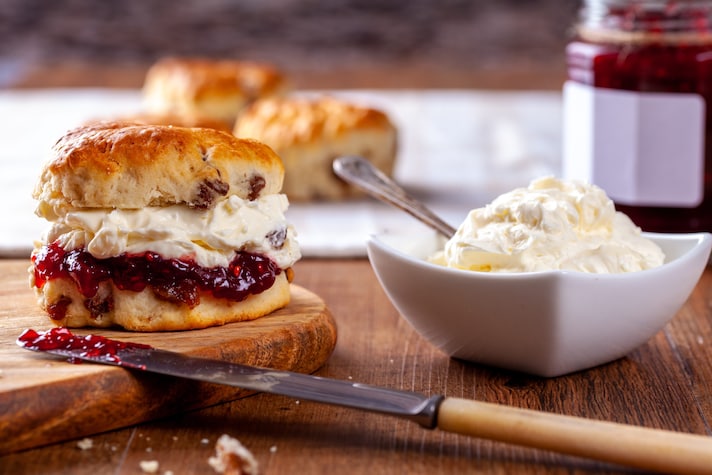Clotted Cream: the easy recipe for a tea-time essential
;Resize,width=742;)
Ingredients
No afternoon tea is complete without clotted cream and scones. This British recipe for clotted cream is a specialty of the south of England in regions like Cornwall and Devon where dairy farms are abundant. Clotted cream has a rich, sweet taste that is perfect as an accompaniment to tea, just like jam or lemon curd.
You can spread it over a muffin or even stir it into a savory sauce just before serving it to make it richer and thicker. Clotted cream also makes a great topping for hot cocoa if you want an ultra-decadent experience. You only need heavy cream to make clotted cream at home, so it's a perfect excuse to try it out!
What is Clotted Cream?
Clotted cream is a cream recipe that comes from the south of England. Regions like Cornwall and Devon are famous for their clotted cream. It's made by heating heavy cream low and slow in the oven, then refrigerating it and skimming off the thick cream that forms.
Clotted cream is richer than heavy cream or whipped cream but has a lighter texture and flavor compared to butter. It's a staple of cream teas and afternoon teas, where it's usually enjoyed over scones, muffins, and other baked treats, but can also be used in savory recipes.
How to Make Clotted Cream
Clotted cream is an incredibly low-effort recipe to make. Pour your heavy cream into a wide, shallow casserole dish. Place it in an oven preheated to 170F, and leave it to gently heat for 12 hours. After the 12 hours are up, take the dish out of the oven and let it cool completely to room temperature.
Once cooled, cover the casserole dish and refrigerate the cream for at least 8 hours. Take it out of the fridge the next day, then lightly skim off the thick clotted cream, making sure to leave behind the thinner milky liquid. Stir the cream and either stash it in your fridge for later use or go ahead and pop it on a scone straight away!
How to Serve Clotted Cream
There are so many wonderful ways to use clotted cream. Dolloping it over traditional English scones, muffins, and sweet quick bread is always delicious.
In savory recipes, use clotted cream as a garnish for tasty mashed potatoes, risotto, pasta with cream sauces, soups, sauces, or mixed with fresh herbs and spices and used as a dip served with crudités.

Tips for Homemade Clotted Cream
Clotted cream is ideal for making overnight.
Don't cover your cream when cooking it.
The thinner liquid that gets left behind once you've removed the clotted cream is perfect for baking! Use it instead of milk or water in other recipes.
To prevent your cream from browning while in the oven, you may need to turn your oven off, then turn it back on again periodically. Browned cream isn't ruined – it'll just have a richer flavor and the cream might not be one hundred percent white.
Leave the cream in the fridge overnight so it won't turn out runny. Also, be sure not to get any of the thinner liquid in with the cream when you're skimming it off.
You don't need an oven to make clotted cream. Use a slow cooker instead.
How to Store Homemade Clotted Cream
Keep your clotted cream in an airtight container and refrigerate. Use within two weeks. Frozen clotted cream will last for 6 months.
Instructions
Preheat your oven to 170° F.
Put the cream in a casserole dish. Transfer the dish to the oven and leave for 12 hours.
Remove the casserole dish from the oven and let it cool completely. Cover and refrigerate for 8 hours.
Remove from the fridge. Lightly skim off the layer of clotted cream from the surface and place it in a bowl. Stir.
Store or use immediately.
Notes
Use a shallow casserole dish for making clotted cream. The cream should only come up 1 to 2 inches up the sides of the dish.
;Resize,width=767;)


;Resize,width=712;)
